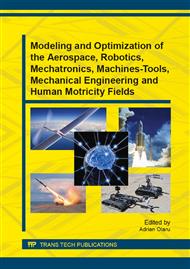[1]
McMichael, J. M., Francis, M. S., Micro Air Vehicles - Toward a new Dimension in Flight, Tech. rep., Defence Advanced Research Projects Agency TTO Document, (1996).
Google Scholar
[2]
Shyy, W., et. al. Computational Aerodynamics of Low Reynolds Number Plunging, Pitching and Flexible Wings for MAV Application, 46th AIAA Aerospace Sciences Meeting and Exhibit, Michigan, (2008).
DOI: 10.2514/6.2008-523
Google Scholar
[3]
Rakotomamonji, T., Ouladsine, M., Moing, T. M., longitudinal modeling and control of a flapping wing micro aerial vehicle, Control Engineering Practice, Vol. 18, pp.679-690, (2010).
DOI: 10.1016/j.conengprac.2010.02.002
Google Scholar
[4]
Ellington, C., The Aerodynamics of Hovering Insect Flight. I. The Quasi-Steady Analysis, Philosophical Transactions of the Royal Society of London. Series B: Biological Sciences, Vol. 305, No. 1122, 1984, pp.1-15.
DOI: 10.1098/rstb.1984.0049
Google Scholar
[5]
Ellington, C., The Aerodynamics of Hovering Insect Flight. III. Kinematics, Philosophical Transactions of the Royal Society of London. Series B: Biological Sciences, Vol. 305, No. 1122, 1984, pp.41-78.
DOI: 10.1098/rstb.1984.0051
Google Scholar
[6]
Orlowski, C. T., Girard, A. R., Dynamics, Stability, and Control Analyses of Flapping Wing Micro-Air Vehicle, Progress in Aerospace Sciences, Vol. 51, 2012, pp.18-30.
DOI: 10.1016/j.paerosci.2012.01.001
Google Scholar
[7]
Sanjay, P. S., and Dickinson, M. H., The Control of Flight Force by a Flapping Wing: Lift and Drag Production, Journal of Experimental Biology, Vol. 204, 2001, pp.2607-2625.
DOI: 10.1242/jeb.204.15.2607
Google Scholar
[8]
Dickinson, M. H., Lehmann, F.O., Sane. S.P., Wing Rotation and the Aerodynamic Basis of Insect Flight, Science, Vol. 199, 1999, pp.1954-1860.
DOI: 10.1126/science.284.5422.1954
Google Scholar
[9]
Khodabakhsh, H., Banazadeh, A., Multi-Objective Genetic Algorithm for Hover Stabilization of an Insect-Like Flapping Wing, Applied Mechanics and Materials, Vol. 332, 2013, pp.344-355.
DOI: 10.4028/www.scientific.net/amm.332.50
Google Scholar
[10]
Sane S. P. and Dickinson M. H., 'The Aerodynamic Effects of Wing Rotation and a Revised Quasi-Steady Model of Flapping Flight, J. Exp. Biol. Vol. 205, 2002 pp.1087-1096.
DOI: 10.1242/jeb.205.8.1087
Google Scholar
[11]
Shyy, W., Lian, Y., Tang, J., Viieru, D., Liu, H., Aerodynamics of low Reynolds number flyers, NewYork, NY: Cambridge University Press; (2008).
DOI: 10.1017/cbo9780511551154
Google Scholar
[12]
Karasek, M., Preumont, A., Simulation of Flight Control of a Hummingbird Like Robot Near Hover, 18th International Confrence Engineering Mechanics 2012, Svratka, Czech Republic, pp.607-619, May (2012).
Google Scholar


